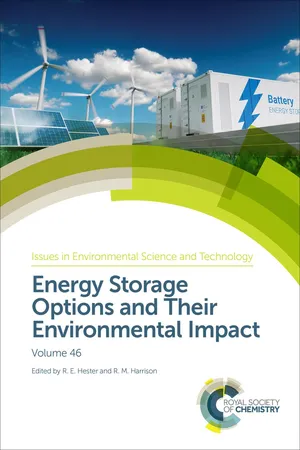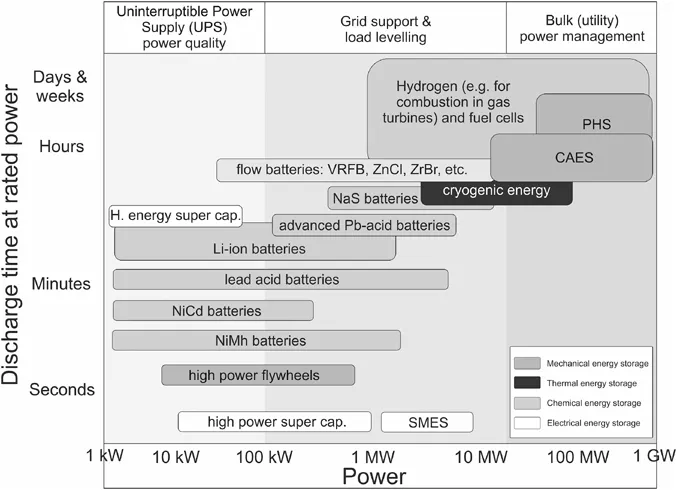
- 334 pages
- English
- ePUB (mobile friendly)
- Available on iOS & Android
Energy Storage Options and Their Environmental Impact
About This Book
Recent decades have seen huge growth in the renewable energy sector, spurred on by concerns about climate change and dwindling supplies of fossil fuels. One of the major difficulties raised by an increasing reliance on renewable resources is the inflexibility when it comes to controlling supply in response to demand. For example, solar energy can only be produced during the day. The development of methods for storing the energy produced by renewable sources is therefore crucial to the continued stability of global energy supplies.
However, as with all new technology, it is important to consider the environmental impacts as well as the benefits. This book brings together authors from a variety of different backgrounds to explore the state-of-the-art of large-scale energy storage and examine the environmental impacts of the main categories based on the types of energy stored.
A valuable resource, not just for those working and researching in the renewable energy sector, but also for policymakers around the world.
Frequently asked questions
Information
ABSTRACT
1 Introduction
- PHS – This is a type of hydroelectric energy storage used by electric power systems for load balancing. Energy is stored in the form of gravitational potential energy of water, pumped from a lower to a higher elevation reservoir. Typically, pumps are run by low-cost surplus off-peak electric power. During periods of high or peak electrical demand, release of the stored water through turbines generates electric power. Pumped hydroelectric storage is, however, a proven technology that can reliably deliver a large-scale and fast-responding storage capacity.8 It is the most common form of energy storage, with a capacity of 188 GW, representing 96% of the total global energy storage capacity.7 Geography, however, constrains the ultimate capacity for PHS and, as such, in most developed countries only limited prospects exist for further development, including in the UK,9,10 although significant potential for hydro-storage capacity may still exist in many other areas around the world.11
- Conventional (diabatic) CAES, or adiabatic compressed air energy storage (ACAES) – This is essentially equivalent to PHS in terms of applications, output and storage capacity. CAES is the second commercially proven, large-scale electrical energy storage (EES) after PHS, but instead of pumping water from a lower to a higher reservoir during periods (generally off-peak) of excess power or energy produced by base gas-, oil-, nuclear- or coal-fired units, air is compressed and stored in an air store ‘reservoir’ (currently salt caverns). As with pumped storage, release of power can be very quick and at peak times, as the air is withdrawn and used in the generation of electricity. CAES is viewed increasingly as offering bulk storage potential and a solution to levelling intermittent renewables generation [wind-power and solar photovoltaic (PV) plants] and maintaining a system balance.12,13 CAES technology is based on the principle of traditional gas-turbine plants and has some advantages over pumped storage, including the fact that its visible impact on the landscape is lower and there is more scope for building CAES facilities nearer the centres of wind-power production, especially in Germany and areas of the USA. Worldwide CAES capacity is 431 MW.8 CAES is not, however, an independent system, as it requires gas for heating of air and has to be associated with a gas-turbine plant during electricity generation – it cannot be used in other types of power plant during generation.14 More importantly, the requirement for combusting fossil fuels and the associated emissions make CAES less attractive compared with other EES technologies.15–17 However, advances in CAES technologies and linking to renewables generation (including offshore wind) offer the prospect of improved cycle efficiencies, with the reduction and possibly elimination of emissions.


2 Pumped Hydroelectric Storage – Introduction to the Technology, Geology and Environmental Aspects
Table of contents
- Cover
- Title Page
- Copyright Page
- Preface
- Contents
- Editors
- List of Contributors
- Energy Sources and Supply Grids – The Growing Need for Storage
- Mechanical Systems for Energy Storage – Scale and Environmental Issues. Pumped Hydroelectric and Compressed Air Energy Storage
- Electrochemical Energy Storage
- Electrical Storage
- Photochemical Energy Storage
- Thermal and Thermochemical Storage
- Smart Energy Systems
- Life-cycle Analysis for Assessing Environmental Impact
- Business Opportunities and the Regulatory Framework
- Subject Index